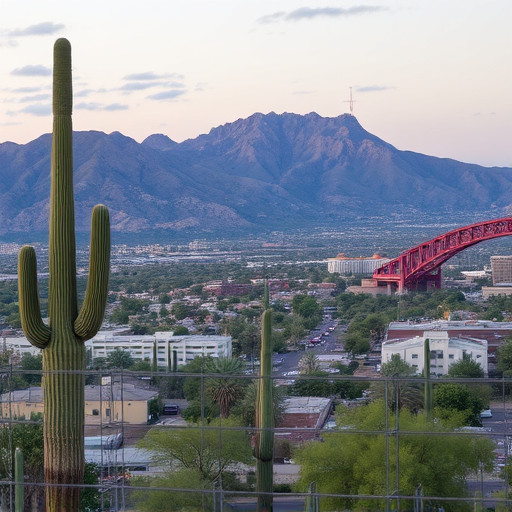Tucson's historic preservation tax credits have revitalized the city's real estate market by encouraging the renovation of 1920s-era properties, boosting property values and preserving architectural heritage. These tax breaks cover significant rehabilitation costs while maintaining historical accuracy, fostering a thriving market for vintage homes and attracting out-of-state buyers who appreciate Tucson's rich history. The strict eligibility criteria ensure that renovations respect original features, balancing historical preservation with modern functionality. Navigating the application process requires meticulous attention to detail, but it offers substantial financial assistance for qualified projects, enhancing Tucson's cultural landscape.
In the heart of Tucson, historic buildings tell tales from the 1920s, their elegance waiting to be restored. Thankfully, Historic Preservation Tax Credits offer a vibrant incentive for these revitalizations. This article delves into this powerful tool for preserving Tucson’s real estate heritage. From understanding the credits’ scope to navigating the application process, we explore how they benefit property owners while transforming the local market. Discover how these incentives are revolutionizing Tucson’s historic landscape.
- Understanding Historic Preservation Tax Credits
- The Impact on Tucson Real Estate Market
- Eligibility Criteria for 1920s Renovations
- Benefits and Incentives for Property Owners
- Navigating the Application Process
Understanding Historic Preservation Tax Credits

Historic preservation tax credits are a powerful incentive for Tucson real estate owners looking to renovate properties from bygone eras, particularly the 1920s. These credits, designed to encourage the preservation and restoration of historical buildings, offer significant financial benefits to those who invest in maintaining our city’s architectural heritage. By taking advantage of these tax breaks, homeowners not only safeguard a piece of Tucson’s past but also enhance their properties’ value, contributing to the overall allure and character of the neighborhood.
Eligible projects range from structural renovations to interior restorations, as long as they adhere to established historical standards. This includes preserving original features like hardwood floors, built-in bookcases, or period-specific fixtures. Understanding these credits can be a game-changer for Tucson real estate owners, allowing them to make informed decisions while ensuring their investments are both profitable and historically responsible.
The Impact on Tucson Real Estate Market

The introduction of historic preservation tax credits has significantly influenced the Tucson real estate market, particularly for renovations dating back to the 1920s. This incentive program encourages property owners and developers to restore and preserve historical buildings, which in turn boosts the city’s cultural heritage and architectural diversity. As a result, many Tucson residents and investors are now embracing the potential of older properties, driving up demand and fostering a vibrant market for 1920s-era real estate.
These tax credits provide financial relief to those involved in rehabilitation projects, making it more economically viable to restore these vintage homes and commercial spaces. This trend has not only revitalized neighborhoods but also attracted attention from out-of-state buyers who appreciate the unique character and history that 1920s architecture brings to Tucson’s real estate landscape. The market response has been positive, with increased property values and a growing interest in preserving the city’s rich architectural heritage.
Eligibility Criteria for 1920s Renovations

In the vibrant landscape of Tucson Real Estate, historic homes from the 1920s hold a special charm. To encourage the preservation of these architectural gems, specific eligibility criteria for renovations must be met to qualify for tax credits. These credits not only incentivize the restoration process but also ensure that the structural integrity and unique aesthetic of the era are maintained.
Renovations must adhere to strict guidelines, focusing on preserving original features such as windows, doors, and exterior cladding while updating interior spaces. The key lies in balancing historical accuracy with modern functionality, ensuring the home’s character is preserved for current and future generations of Tucson residents to appreciate.
Benefits and Incentives for Property Owners

Renovating a historic property in Tucson can be a rewarding endeavor, thanks to the benefits and incentives available through Historic Preservation Tax Credits. For homeowners looking to restore or preserve their 1920s-era homes, these tax credits offer substantial financial assistance. Not only do they encourage the preservation of architectural heritage, but they also provide an excellent opportunity for property owners to offset the costs of renovation projects.
Property owners can claim tax credits for a significant portion of eligible expenses, including labor and materials used in restoring or rehabilitating their properties. This incentive is particularly advantageous for Tucson Real Estate investors and homeowners who wish to maintain the historical integrity of their homes while enhancing their living spaces. By taking advantage of these tax credits, residents contribute to the city’s rich cultural landscape and ensure that the unique architectural charm of the 1920s lives on in Tucson’s real estate market.
Navigating the Application Process

Navigating the application process for historic preservation tax credits in Tucson real estate can seem daunting, but it’s a worthwhile endeavor for property owners looking to renovate heritage buildings. The first step involves researching and identifying eligible properties, which are typically structures listed on the National Register of Historic Places or located in designated historical districts. Once a property is confirmed as eligible, applicants must gather essential documents, including architectural plans, historical information about the building, and cost estimates for the renovation project.
The application process requires careful attention to detail and adherence to specific guidelines set by the state and federal agencies overseeing historic preservation. In Tucson, this often involves submitting forms to both the local historical commission and the state historic preservation office. It’s crucial to ensure all required documentation is accurately completed and submitted on time. Property owners may also want to consult with experts, such as architects specializing in historical renovations, to maximize their chances of a successful application.
Tucson’s rich history comes alive through its architectural landscapes, and historic preservation tax credits play a pivotal role in preserving this heritage. By offering incentives for 1920s renovation projects, these credits not only encourage the restoration of valuable historical properties but also contribute to the vibrancy of the Tucson real estate market. Understanding the eligibility criteria and navigating the application process can unlock significant benefits for property owners, ensuring that the city’s past is protected while fostering a sustainable future.
